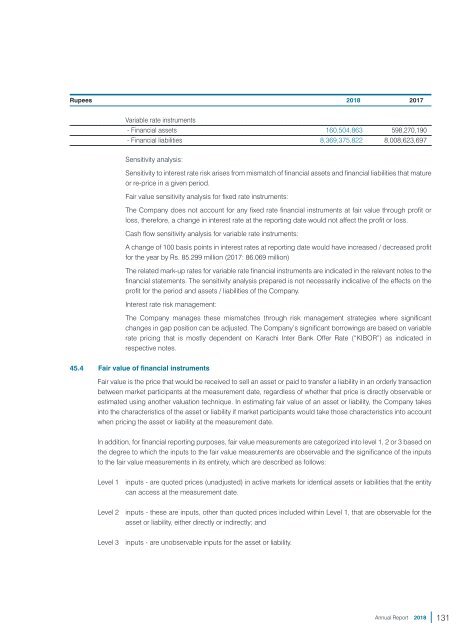MS AR 2018 (1)
Create successful ePaper yourself
Turn your PDF publications into a flip-book with our unique Google optimized e-Paper software.
Rupees <strong>2018</strong> 2017<br />
Variable rate instruments<br />
- Financial assets 160,504,863 598,270,190<br />
- Financial liabilities 8,369,375,822 8,008,623,697<br />
Sensitivity analysis:<br />
Sensitivity to interest rate risk arises from mismatch of financial assets and financial liabilities that mature<br />
or re-price in a given period.<br />
Fair value sensitivity analysis for fixed rate instruments:<br />
The Company does not account for any fixed rate financial instruments at fair value through profit or<br />
loss, therefore, a change in interest rate at the reporting date would not affect the profit or loss.<br />
Cash flow sensitivity analysis for variable rate instruments:<br />
A change of 100 basis points in interest rates at reporting date would have increased / decreased profit<br />
for the year by Rs. 85.299 million (2017: 86.069 million)<br />
The related mark-up rates for variable rate financial instruments are indicated in the relevant notes to the<br />
financial statements. The sensitivity analysis prepared is not necessarily indicative of the effects on the<br />
profit for the period and assets / liabilities of the Company.<br />
Interest rate risk management:<br />
The Company manages these mismatches through risk management strategies where significant<br />
changes in gap position can be adjusted. The Company’s significant borrowings are based on variable<br />
rate pricing that is mostly dependent on Karachi Inter Bank Offer Rate (“KIBOR”) as indicated in<br />
respective notes.<br />
45.4 Fair value of financial instruments<br />
Fair value is the price that would be received to sell an asset or paid to transfer a liability in an orderly transaction<br />
between market participants at the measurement date, regardless of whether that price is directly observable or<br />
estimated using another valuation technique. In estimating fair value of an asset or liability, the Company takes<br />
into the characteristics of the asset or liability if market participants would take those characteristics into account<br />
when pricing the asset or liability at the measurement date.<br />
In addition, for financial reporting purposes, fair value measurements are categorized into level 1, 2 or 3 based on<br />
the degree to which the inputs to the fair value measurements are observable and the significance of the inputs<br />
to the fair value measurements in its entirety, which are described as follows:<br />
Level 1 inputs - are quoted prices (unadjusted) in active markets for identical assets or liabilities that the entity<br />
can access at the measurement date.<br />
Level 2 inputs - these are inputs, other than quoted prices included within Level 1, that are observable for the<br />
asset or liability, either directly or indirectly; and<br />
Level 3 inputs - are unobservable inputs for the asset or liability.<br />
Annual Report <strong>2018</strong><br />
131


